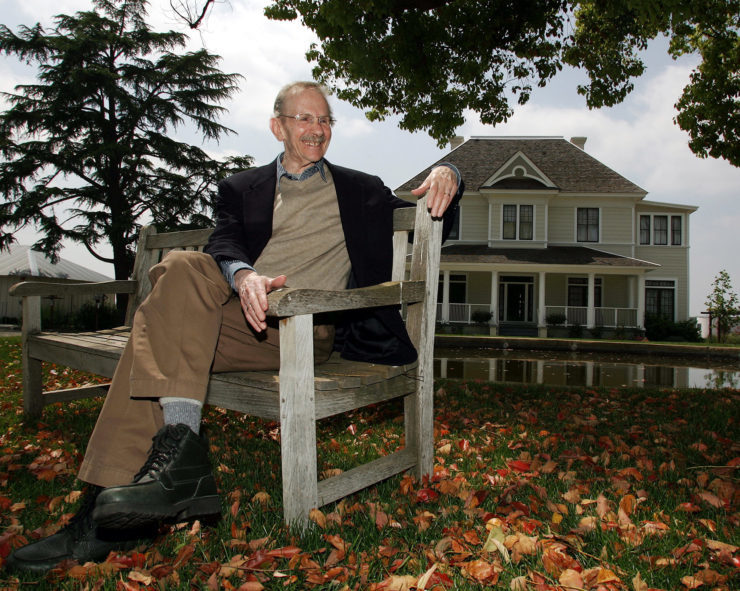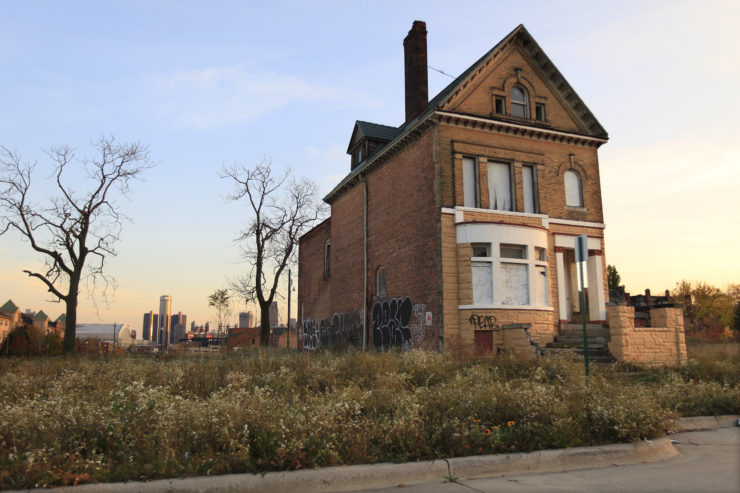
This 2006 file photo shows poet Philip Levine in Fresno, Calif.
I read poetry. Chalk it up to an English degree, perhaps too much Milton or Wordsworth as an undergrad, or a line or two that I once might have penned one dark and stormy night.
But as a journalist, I find poetry something of a closeted pleasure, hard to explain or justify, especially if you read to learn craft. The forms and requirements of each are seemingly contradictory, and whenever I try to answer for them, I turn to the poet Philip Levine, who is quick to remind me that the differences between the two can sometimes be quite arbitrary.
Consider this ode to his cat Nellie, who sat beside him as he worked.
… when the line
got too long she’d reach
one sudden black foreleg down
and paw at the moving hand,
the offensive one. The first
time she drew blood I learned
it was poetic to end
anywhere to keep her
quiet.
– From “A Theory of Prosody”
Levine was a fearless writer – Nellie notwithstanding – and if the mere swat of a cat’s paw distinguishes poems and narratives, then I’m all in. Of course, Levine makes it easy. In his poems – the simple, impassioned, hard-edged documents of his life – I find lessons that inform my own work, lessons that transcend the merits of each form.
Honored chronicler of America’s Rust Belt, Levine invited readers to walk the streets of his hometown, Detroit, and meet the past that he could never escape. Long after he moved to Fresno, where he taught at the university, he revisited the factories, unemployment lines and the vanishing neighborhoods of the Midwest that he knew from his youth.
Levine, who died last year, was a storyteller above all, spinning his yarns in stanza-less poems, blocks of type – thanks to Nellie – that are always neatly measured, briskly paced and almost cinematic in a precision of detail that would embarrass the most economic writer.
Six floor walk-ups, half the windows
boarded up, the doorways bricked over.
Still some families hanging on, kids
flood into the ruined streets morning
after morning on their way to school.
When it dies down, stray animals pick
over the rubbish, a family of four cats
exits the innards of a blooming sofa.
Between 9:30 and afternoon not
a single car starts up or passes down
the street. In the corner grocery
three lopsided apples on special,
30 cents each. The woman says it’s
a good neighborhood, ain’t no violence
here, ain’t no trouble. A man comes
out of the back room and stares
at me until I look away. No one
speaks, not even the radio. The light
of the world filters down from shelves
of Brillo, bright packages of detergent,
paper diapers, roach motels, white
stale saltless crackers. Moment
by yellow moment the day ticks into
the past, and no one tries anything.
– From “These Streets”
Critics took him to task for this style. One – Harvard’s esteemed Helen Vendler – wrote that he was “simply a memoir-writer in prose who chops up his reminiscent paragraphs into short lines.”
In his poems – the simple, impassioned, hard-edged documents of his life – I find lessons that inform my own work.
“Is there any compelling reason why it should be called poetry?” she asked, but Levine knew, perhaps intuitively, that the more simple the syntax, the more immediate the portrait. Blurring the line between poetry and prose, he put the narrative before melody and often accomplished both.
He erased the distance between himself and his subject and exercised an identification with people and places that brings to mind some of the most memorable pieces of literary journalism (think Michael Lewis or Susan Orleans). Rather than tell the story at an arm’s length, he enters each moment completely, following the simple maxim that the more intimately you render the world, the more universal its meaning.
Half an hour to dress, wide rubber hip boots,
gauntlets to the elbow, a plastic helmet
like a knight’s but with a little glass window
that kept steaming over, and a respirator
to save my smoke-stained lungs. I would descend
step by slow step into the dim world
of the pickling tank and there prepare
the new solutions from the great carboys
of acids lowered to me on ropes …
– From “Fear and Fame”

A graffiti-marked abandoned home north of downtown Detroit, in background.
Like a memoirist (Vendler was accurate in that), Levine is often at the center of his story. Poetry is, after all, a genre of self-exploration, but his work is never self-absorbed. His sensibility merely informs the reporting and provides a lens that shapes and moderates the city, the people, the memories that he evokes. Sometimes I think journalists should make similar descents, if not just to understand their relationship to the story, then to find fresh language to capture its urgency.
Reporters who cover the industrial Midwest will recognize his landmarks – families torn apart by poverty, neighborhoods whose promise long disappeared. But where showing – not telling – is often the standard for such work, Levine suggests that there is value in taking the reader by the hand.
We stand in the rain in a long line
waiting at Ford Highland Park. For work.
You know what work is – if you’re
old enough to read this you know what
work is, although you may not do it.
Forget you. This is about waiting,
shifting from one foot to another.
– From “What Work Is”
He is there to make introductions to the survivors, the workers, those who have struggled for so long to find work and meaning in their lives, and if his tone at times is cut with impatience, it is because he has been here so many times before.
Levine once told an interviewer: “I think the writing of a poem as a political act. The sources of anger are frequently social, and they have to do with the fact that people’s lives are frustrated, they’re lied to, they’re cheated, that there is no equitable handing out of the goods of this world.”
My anger is sudden and total,
for I am a man to whom anger
usually comes slowly, spreading
like a fever along my shoulders
and back and turning my stomach
to a stone, but this fox anger
is lyrical and complete, as I stand
in the pathway shouting and refusing
to budge, feeling the dignity
of the small creature menaced
by the many and larger.
– From “The Fox”
In some 20 books of poetry, he mined this fox-anger to create a body of work that is both lyrical and demanding. His voice modulates from the fury of his celebrated “They Feed They Lion” of 1968 to the wistfulness of one of his final poems, “The Last Shift.”
Caught in traffic on his way to work, he looks around him: 7:30 in the morning and the neighborhood rises up around him like a dream. Men keep warm by a fire “made from fence posts and garage doors.” Police sit in their car eating sugar doughnuts “as delicately as two elderly women,” and children descend from lightless houses, “gloved and scarved, on their way to school.”
These quiet moments of everyday life are haunted by emblems of their own impermanence, the wreckage of a failed economy. Beside him stands a two-storied house “all of its / rooms torn into view, its connections / and tubing gone, the furniture gone, / the floors ripped up for firewood.”
As neighborhoods are emptied, factories torn down – the unwinding, as George Packer called it in his 2013 book – Levine confronts a truth more troubling than the loss of place: a willful blindness to the suffering of others.
If I told you that the old woman
named Ida Bellow was shot to death
for no more than $5 and that a baby
of eighteen months saw it all from
where she wakened on the same bed
but can’t tell you because she can’t speak,
you’d say I was making it up.
– From “These Streets”
Throughout his portraits of American life, he pushes his readers to understand the nature of this disregard: The working class has been hard to see, because seeing means confronting the struggle of their lives, a struggle of race and inequality.
Growing up during the Depression, the son of Russian-Jewish immigrant parents, and coming of age during the race riots and labor battles of the 1940s, he found in his disappointment a voice for the squandered opportunities of this republic and in its potential for change.
The ship that took my mother to Ellis Island
eighty-three years ago was named “The Mercy.”
She remembers trying to eat a banana
without first peeling it and seeing her first orange
in the hands of a young Scot, a seaman
who gave her a bite and wiped her mouth for her
with a red bandana and taught her the word,
“orange,” saying it patiently over and over.
– From “The Mercy”
Reading Levine’s poetry reveals a writer who was not only confident in his vision of the America, but who was also humbled by the world around him. In one of his final poems, he takes a walk in the woods.
“About life I can say nothing,” he begins, and as he listens to the wind in the pines, he writes, “How weightless / words are when nothing will do.”
But of course he knew that the corollary is just as true: how vital words are when so much is at stake.


